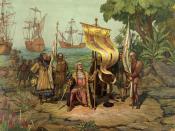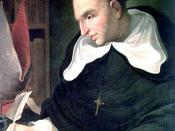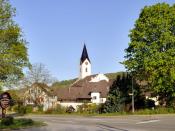The Catholic Church during the Middle Ages played an all-encompassing role over the lives of the people and the government. As the Dark Ages came to a close the ideas of the Renaissance started to take hold, and the church's power gradually began to wan. The monarchies of Europe also began to grow replacing the church's power. Monarchies, at the close of the Middle Ages and the dawn of the Renaissance, did not so much seek the guidance of the church as much as it sought their approval. However, the Church during the Age of Discovery was still a major influence. The discovery of the New World and its previously unknown inhabitants presented new problems in the Catholic Church in the late 14th and early 15th century. When Spain's rulers and emissaries decided to physically conquer and populate the New World, and not just trade with it, the transplantation of Christian institutions followed.
The church established contact with the New World, and made it a goal to establish the Catholic doctrines among the native population there. The Catholic Church and the Spanish monarch, however, looked upon the native population in the New World as souls to be saved. They did not consider or treat the Indians as equals. The implanting of Christianity in the New World, and the treatment of the native population by the missionaries and Christian conquerors was detrimental to New World. Through men such as Cortez and Las Casas accounts of the conversions have been recorded. One of the reasons for this was the alliance of the Catholic Church with the Spanish monarchy. The status of the Indians was disregarded as the Christian conquers and missionaries who wanted to convert them subjected them to violence and reduced them to a laboring population. The Indians however,


